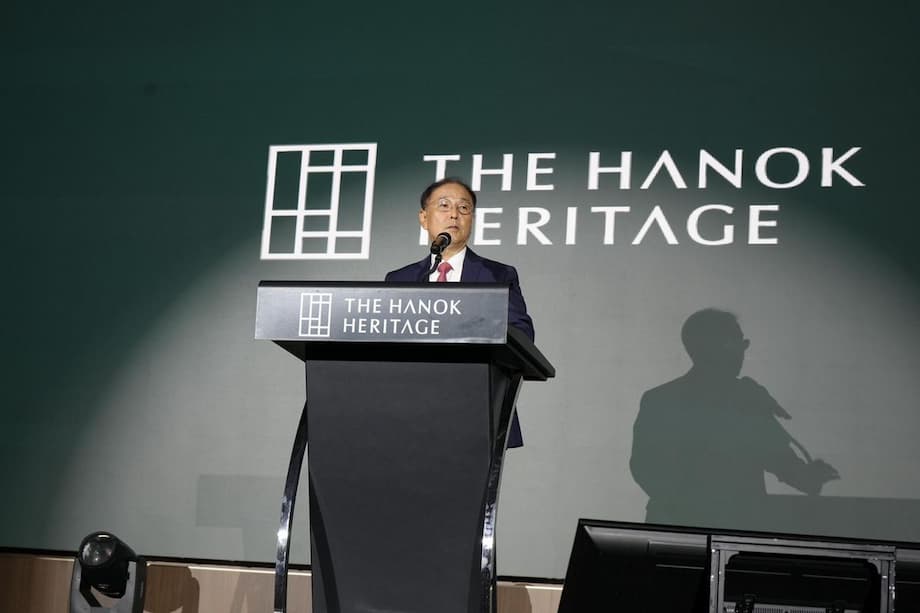A new landmark for living heritage
Korea’s largest hanok hotel has opened to the public in the mountains of Yeongwol, Gangwon Province, inviting guests to experience traditional Korean architecture with contemporary comfort. The Hanok Heritage Hotel, once a secluded estate for members only, now welcomes travelers into a setting shaped by hand crafted timber, pine scented courtyards, and windows that frame forested hills and the Seogang River. The team behind the project describes it as New Heritage, an approach that preserves the quiet soul of hanok living while solving the practical issues that kept many traditional houses from serving as modern hotels.
- A new landmark for living heritage
- Where is it, and what sets it apart
- Rooms, rates, and what the stay includes
- Dining, wellness, and cultural programs
- A design story rooted in craft and innovation
- Award winning architecture and international attention
- From private retreat to public hotel
- What hanok means, and how this hotel interprets it
- How to plan a visit
- At a Glance
The estate sits in Mungaesil village on roughly 337,000 square meters of land, a size that helps the place feel like a hamlet rather than a single property. Stone walls line walkways. An 84 meter interior corridor draws a graceful line between wings. At night, exterior lights are dimmed or turned off to reveal a sky filled with stars, an experience that gives the hotel’s signature pavilion, Byeoljae, a sense of theater as guests gather for a tasting of traditional drinks and seasonal bites. The opening marks a shift in access. Where the property once catered to a small circle, 14 rooms are now available to the public, supported by galleries, a lounge, and cultural programs designed to introduce the logic and spirit of hanok.
Where is it, and what sets it apart
The Hanok Heritage Hotel is located in Nam myeon, Yeongwol gun, a rural area surrounded by mountains and the meandering Seogang River. The site selection was deliberate. Traditional hanok planning emphasizes harmonious placement in nature, with structures oriented for light, wind, and views. Here, broad eaves, courtyards, and reflective ponds filter sound and heat, while pathways deliver a slow reveal of spaces. Several buildings draw inspiration from Jongmyo Jeongjeon in Seoul, a royal shrine defined by rhythm, proportion, and a long axial hall. That reference appears in the property’s elongated corridor and in the cadence of columns and beams that guide movement from lodging to pavilion to gallery.
Crafted surfaces and hidden technology coexist across the estate. Timbers are cut and polished by master carpenters, while glass and insulation are tucked behind traditional profiles to deliver quiet rooms and steady indoor temperatures. The style reads as classic hanok, yet doors glide smoothly, the floors are warm, and the air stays fresh. Even the furniture is custom made to echo the curves and joinery of old houses.
Rooms, rates, and what the stay includes
The public hotel wing offers 14 rooms with four core layouts, including Gaon, Sol, Sodam, and Corner Suite San. Views vary from stone walls and pine groves to framed vignettes of hills and sky. Each room includes breakfast and welcome tea, a curated minibar, and access to the property’s gallery and quiet lounge. Staff lead daily hanok docent tours that explain building techniques, site planning, and the ways that verandas and courtyards shape daily life. Evenings often culminate at Byeoljae for Soolsi, a tasting of traditional liquor paired with small dishes that change with the season.
Rates for the public rooms generally range from 1.2 million to 2.7 million won per night, reflecting the level of privacy, size, and views. Accessibility was considered in the planning. The hotel offers rooms designed to support wheelchair users and older guests, with gentle slopes and discreet assistance features. Ten additional houses remain part of the members area, maintaining the original private retreat concept alongside the new hotel inventory.
Dining, wellness, and cultural programs
Two restaurants anchor the culinary program. Namu serves seasonal Korean dishes throughout the day, while Monto offers a fine dining tasting menu built around regional ingredients and traditional techniques presented with a contemporary touch. Gugak performances and hosted tastings add a cultural layer to meals during special services and events. The food emphasizes clarity and restraint, matching the architecture’s clean lines.
The property curates activities that encourage slow living. Guests can try on royal hanbok for photos in the courtyard, join digital detox and sleep meditation sessions, or play traditional games on the lawn. Stargazing sessions often follow the nightly lights out tradition, when the estate darkens to reveal the Milky Way far from urban glare. Several programs invite reflection, including rituals that begin the morning with a gentle bell and end the day with quiet journaling on hanji paper. The goal is not spectacle but presence, an approach that mirrors the way hanok spaces tune the senses to breeze, birdsong, and shifting light.
A design story rooted in craft and innovation
Building a hanok that functions as a modern hotel requires more than good carpentry. It calls for material science, patience, and a clear idea of where to respect tradition and where to update it. The Hanok Heritage team enlisted master carpenters, known in Korea as daemokjang, along with contemporary designers and engineers. One of the most persistent problems in historic hanok is moisture management. Poorly dried timber warps and cracks, which invites drafts and odors. The Yeongwol project invested in wood drying and processing to stabilize the structure before assembly. Windows that once used paper are now layered with tempered glass and near transparent screens, improving insulation while keeping sightlines open to nature.
Cho Chung il, the founder of The Hanok Heritage and the chief executive of KONA I, has been the public face of that rethink. He studied traditional houses across the country, then pulled together a team to test new processes and details until they could hold up in all seasons without losing the visual language of hanok. After years of prototypes and mock ups, the joinery, windows, and furniture now feel familiar but perform to the standards of a quiet, well sealed lodge.
In interviews, Cho has been direct about the central challenge that had to be solved.
It all comes down to how we dry the wood.
The plan for Yeongwol is equally explicit, with a clear target for completion and a final mix of public and members spaces.
Our hanok complex will be completed by early 2028 when 30 hanok units are up and running.
He has also said the aim is comfort first, even in a property that looks like a historic village.
It is the comforts of home, a space that overwhelms you once you step in.
Traditional experts read the project as an inflection point. Some see it as a last chance to prove that hanok can be more than museum pieces in a fast urbanizing country. One master carpenter put it bluntly after walking the site and inspecting the details.
This is the last chance for hanok.
Award winning architecture and international attention
The Hanok Heritage has drawn global attention for design that blends authentic form with high performance construction. The property earned the top hotel honor at the Prix Versailles (2024), an international architecture and design award presented in Paris. Judges look at cultural resonance, innovation, and environmental sense. The project also received an IIDA Global Design Award, a signal from the interior design community that the detailing inside the rooms and public spaces matches the ambition outside.
Recognition has been mirrored by interest from travelers and public figures. Celebrities have shared photos from their stays, yet the estate never feels crowded thanks to the spread of buildings, courtyards, and trails. The galleries and pavilion host small events, and the banquet hall, often called Yeongbin Hall, provides a venue for cultural gatherings, retreats, and discreet celebrations that fit the character of the place.
From private retreat to public hotel
The Yeongwol property began as a constellation of private hanok for members. That period served as a test bed for the construction methods and hospitality concept. Opening to the public with 14 rooms is a pivot grounded in mission. The team behind The Hanok Heritage has said that the goal is to share an experience once reserved for a few thousand guests each year with a wider audience, including international visitors who want to encounter traditional Korean space in a calm, generous setting.
Expansion is already planned. By 2028, the broader complex is set to include new houses for both members and hotel guests, outdoor facilities that maintain a hanok silhouette, and cultural spaces that can host exhibitions and forums. The founder has also described a vision for a long hanok street in Seoul, a demonstration of tradition and technology on a city scale. Conversations about future projects in New York and Paris show the ambition to make hanok a global reference for warm, sustainable, human centered design.
What hanok means, and how this hotel interprets it
Hanok describes a traditional Korean house, usually built with timber frames, clay tiled roofs, and paper lined interiors. The layout aims for balance with the landscape, from the way buildings sit on stone foundations to the placement of courtyards that catch sun in winter and shade in summer. Rooms open to the outside through sliding doors, and circulation moves along wooden verandas that blur indoor and outdoor space. The heart of a classic hanok is a system of radiant heating known as ondol, which warms floors from below and makes sitting on mats and low furniture both natural and comfortable.
Modern life complicates that model. Today’s travelers expect quiet rooms, conditioned air, and even bathroom amenities that never existed in the past. The Hanok Heritage Hotel treats hanok as a living idea instead of a fixed artifact. Floors still feel warm underfoot and rooms breathe, yet the walls keep sound at bay and the glass is clear to the horizon. During a stay, guests move slowly between garden pavilions and shaded porches. The payoffs are sensory and emotional rather than flashy, from the scent of pine and paper to the soft percussion of summer rain on clay tiles.
How to plan a visit
The Hanok Heritage Hotel sits outside town, so most visitors arrive by car from Seoul or by intercity bus or train to Yeongwol followed by a short taxi ride. The property’s remoteness is part of the appeal. Night skies are crisp, and mornings unfold with mist rising from the river. The hotel recommends booking programs in advance, especially docent tours, hanbok fittings, and stargazing sessions, which have limited capacity. Dinner at Monto or a window table at Namu can also be reserved ahead of time during busy weekends.
Bookings and information about room categories, accessibility, and cultural programming are available on the official website. Visitors interested in the public hotel wing should focus on the 14 open rooms, while those exploring private stays can inquire about the members area and future availability. For current details, see the hotel’s overview page at The Hanok Heritage Hotel.
At a Glance
- Korea’s largest hanok hotel has opened to the public in Yeongwol, Gangwon Province.
- Fourteen rooms are available to book now, with ten additional houses reserved for members.
- Rates for public rooms generally range from 1.2 million to 2.7 million won per night.
- The estate spans about 337,000 square meters, with an 84 meter corridor linking key wings.
- Dining includes Namu for seasonal fare and Monto for a Korean tasting menu.
- Daily programs feature hanok docent tours, Soolsi tastings, hanbok fittings, meditation, and stargazing.
- Design updates address common hanok issues with advanced wood drying and insulated glass.
- The property won the top hotel award at the 2024 Prix Versailles and an IIDA Global Design Award.
- Planned expansion through 2028 will add houses, cultural spaces, and new facilities while preserving the hanok character.




